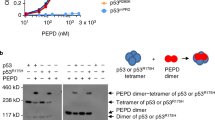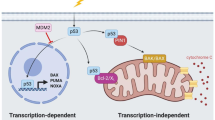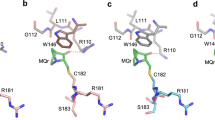Abstract
We demonstrate here that synthetic 22-mer peptide 46, corresponding to the car boxy-terminal amino acid residues 361–382 of p53, can activate specific DNA binding of wild-type p53 in vitro and can restore the transcriptional transactivating function of at least some mutant p53 proteins in living cells. Introduction of peptide 46 in Saos-2 cells carrying a Tet-regulatable His-273 mutant p53 construct caused growth inhibition and apoptosis in the presence of mutant p53 but not in its absence, confirming that the effect of the peptide is mediated by reactivation of mutant p53. Moreover, peptide 46 caused apoptosis in mutant as well as wild-type p53-carrying human tumor cell lines of different origin, whereas p53 null tumor cells were not affected. These findings raise possibilities for developing drugs that restore the tumor suppressor function of mutant p53 proteins, thus selectively eliminating tumor cells.
This is a preview of subscription content, access via your institution
Access options
Subscribe to this journal
Receive 12 print issues and online access
$209.00 per year
only $17.42 per issue
Buy this article
- Purchase on Springer Link
- Instant access to full article PDF
Prices may be subject to local taxes which are calculated during checkout
Similar content being viewed by others
References
Greenblatt, M.S., Bennet, W.P., Hollstein, M. & Harris, C.C. Mutations in the p53 tumor suppressor gene: Clues to cancer etiology and molecular pathogenesis. Cancer Res. 54, 4855–4878 (1994
Malkin, D., et al. Germ line p53 mutations in a familial syndrome of breast cancer, sarcomas, and other neoplasias. Science 250, 1233–1238 (1990
Donehower, L.A., et al. Mice deficient for p53 are developmentally normal but susceptible to spontaneous tumors. Nature 356, 215–221 (1992
Baker, S.J., Markowitz, E.R., Fearon, J.K., Willson, K.V. & Vogelstein, B. Suppression of human colorectal carcinoma cell growth by wild-type p53. Science 249, 912–915 (1990
Yonish-Rouach, E., et al. Wild type p53 induces apoptosis of myeloid leukemic cells that is inhibited by interleukin-6. Nature 353, 345–347 (1991
Kern, S.E., et al. Oncogenic forms of p53 inhibit p53-regulated gene expression. Science 256, 827–832 (1992
Cho, Y., Gorina, S., Jeffrey, P.D. & Pavletich, N.P. Crystal structure of a p53 tumor-suppressor-DNA complex: Understanding tumorigenic mutations. Science 265, 356–355 (1994
Hupp, T.R.,& Lane, D.P. Allosteric activation of latent p53 tetramers. Curr. Biol 4, 865–875 (1994
Hupp, T.R., Sparks, A. & Lane, D.P. Small peptides activate the latent sequence-specific binding function of p53. Cell 83, 237–245 (1995
Hupp, T.R., Meek, D.W., Midgley, C.A. & Lane, D.P. Activation of the cryptic DNA binding function of mutant forms of p53. Nucleic Acids Res. 21, 3167–3174 (1993
Halazonetis, T.D. & Kandil, A.N. Conformational shift propagate from oligomeriza-tion domain of p53 to its tetrameric DNA binding domain and restore DNA binding to select p53 mutants. EMBOJ. 12, 5057–5064 (1993
Niewolik, D., Vojtesek, B. & Kovarik, J. p53 derived from human tumour cell lines and containing distinct point mutations can be activated to bind its consensus target sequence. Oncogene 10, 881–890 (1995
Abarzua, P., et al. Restoration of the transcription activation function to mutant p53 in human cancer cells. Oncogene 13, 2477–2482 (1996
Abarzua, P., LoSardo, J.E., Gubler, M.L. & Neri, A. Microinjecton of monoclonal antibody PAb421 into human SW480 colorectal carcinoma cells restores the transcription activation function to mutant p53. Cancer. Res 55, 3490–3494 (1995
Selivanova, G., et al. The single stranded DNA end binding site of p53 coincides with the C-terminal regulatory region. Nucleic Acids Res. 24, 3560–3567 (1996
Brugidou, J., Legrand, C., Mery, J. & Rable, A. The retro-inverso form of a home-obox-derived short peptide is rapidly internalized by cultured neurones: A new basis for an efficient intracellular delivery system. Biochem. Biophys. Res. Commun. 214, 685–693 (1995
Lowe, S.W., et al. p53 status and the efficacy of cancer therapy in vivo. Science 266, 807–810 (1994
Wieczorek, A.M., Waterman, J.L.F., Waterman, M.J.F. & Halazonetis, T.D. Structure-based rescue of common tumor-derived p53 mutants. Nature Med 2, 1143–1146 (1996
Symonds, H., et al. p53-dependent apoptosis suppresses tumor growth and progression in vivo. Cell 78, 703–711 (1994
Iotsova, V. & Stephelin, D. Antisense p53 provokes changes in HeLa cell growth and morphology. Eur. J. Cell Biol 68, 122–132 (1995
Gossen, M. & Bujard, H. Tight control of gene expression in mammalian cells by tetracycline-responsive promoters. Proc. Natl. Acad. Sci. USA 89, 5547–5551 (1992
Ramqvist, T., et al. Wild type p53 induces apoptosis in a Burkitt lymphoma (BL) line that carries mutant p53. Oncogene 8, 1495–1500 (1993
Okan, I., et al. The EBV-encoded LMP1 protein inhibits p53-triggered apoptosis but not growth arrest. Oncogene 11, 1027–1031 (1995
Author information
Authors and Affiliations
Rights and permissions
About this article
Cite this article
Selivanova, G., Iotsova, V., Okan, I. et al. Restoration of the growth suppression function of mutant p53 by a synthetic peptide derived from the p53 C-terminal domain. Nat Med 3, 632–638 (1997). https://doi.org/10.1038/nm0697-632
Received:
Accepted:
Issue Date:
DOI: https://doi.org/10.1038/nm0697-632
This article is cited by
-
Translating p53-based therapies for cancer into the clinic
Nature Reviews Cancer (2024)
-
The anti-cancer agent APR-246 can activate several programmed cell death processes to kill malignant cells
Cell Death & Differentiation (2023)
-
The influence of a modified p53 C-terminal peptide by using a tumor-targeting sequence on cellular apoptosis and tumor treatment
Apoptosis (2023)
-
Transition of amyloid/mutant p53 from tumor suppressor to an oncogene and therapeutic approaches to ameliorate metastasis and cancer stemness
Cancer Cell International (2022)
-
Caffeic acid phenethyl ester (CAPE) confers wild type p53 function in p53Y220C mutant: bioinformatics and experimental evidence
Discover Oncology (2021)



